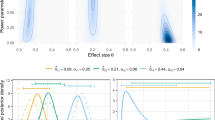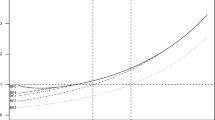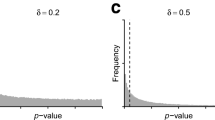Abstract
We put forward an adaptive \(\alpha \) (type I error) that decreases as the information grows for hypothesis tests comparing nested linear models. A less elaborate adaptation was presented in Pérez and Pericchi (Stat Probab Lett 85:20–24, 2014) for general i.i.d. models. The calibration proposed in this paper may be interpreted as a Bayes–non-Bayes compromise, of a simple translation of a Bayes factor on frequentist terms that leads to statistical consistency, and most importantly, it is a step toward statistics that promotes replicable scientific findings.
Similar content being viewed by others
References
Abramowitz M, Stegun IA (1970) Handbook of mathematical functions. National Bureau of Standards, Washington, D.C
Acuna E (2015) Regresión Aplicada usando R. Universidad de Puerto Rico Recinto de Mayagüez, Departamento de Ciencias Matemáticas
Bayarri MJ, Berger JO, Jang W, Ray S, Pericchi LR, Visser I (2019) Prior-based Bayesian information criterion. Stat Theory Relat Fields 3(1):2–13
Benjamin D, Berger J, Johannesson M, Nosek B, Wagenmakers E-J, Berk R, Bollen K, Brembs B, Brown L, Camerer C, Cesarini D, Chambers C, Clyde M, Cook T, De Boeck P, Dienes Z, Dreber A, Easwaran K, Efferson C, Fehr E, Fidler F, Field A, Forster M, George E, Gonzalez R, Goodman S, Green E, Green D, Greenwald A, Hadfield J, Hedges L, Held L, Hua Ho T, Hoijtink H, Hruschka D, Imai K, Imbens G, Ioannidis J, Jeon M, Jones J, Kirchler M, Laibson D, List J, Little R, Lupia A, Machery E, Maxwell S, McCarthy M, Moore D, Morgan S, Munafó M, Nakagawa S, Nyhan B, Parker T, Pericchi L, Perugini M, Rouder J, Rousseau J, Savalei V, Schönbrodt F, Sellke T, Sinclair B, Tingley D, Van Zandt T, Vazire S, Watts D, Winship C, Wolpert R, Xie Y, Young C, Zinman J, Johnson V (2018) Redefine statistical significance. Nat Human Behav 2:6–10
Berger J, Bayarri MJ, Pericchi LR (2014) The effective sample size. Economet Rev 33(1–4):197–217
Berger J, Pericchi L (2001) Objective Bayesian methods for model selection: introduction and comparison. In: Model selection. Institute of Mathematical Statistics, pp 135–207
Casella G, Berger R (2001) Statistical inference, 2nd edn. Duxbury Resource Center
Casella G, Girón J, Martínez L, Moreno E (2009) Consistency of Bayesian procedures for variable selection. Ann Stat 37(3):1207–1228
Cohen J (1988) Statistical power analysis for the behavioral sciences, 2nd edn. Psychology Press
Findley DF (1991) Counterexamples to parsimony and BIC. Ann Inst Stat Math 43:505–514
Johnson VE, Rossell D (2010) On the use of non-local prior densities in Bayesian hypothesis tests. J Roy Stat Soc Ser B (Stat Methodol) 72(2):143–170
Pérez ME, Pericchi LR (2014) Changing statistical significance with the amount of information: the adaptive alpha significance level. Stat Probab Lett 85:20–24
Richter W-D, Schumacher J (2000) Asymptotic expansions for large deviation probabilities of noncentral generalized chi-square distributions. Multivar Anal 75:184–218
Sellke T, Bayarri MJ, Berger JO (2001) Calibration of \(p\) values for testing precise null hypotheses. Am Stat 55(1):62–71
Wasserstein RL, Lazar NA (2016) The ASA statement on \(p\)-values: context, process, and purpose. Am Stat 70(2):129–133
Woods H, Steinour HH, Starke HR (1932) Effect of composition of Portland cement on heat evolved during hardening. Ind Eng Chem 24(11):1207–1214
Acknowledgements
The work of M.E. Pérez and L.R. Pericchi has been partially funded by NIH grants U54CA096300, P20GM103475, and R25MD010399.
Author information
Authors and Affiliations
Corresponding author
Additional information
Publisher's Note
Springer Nature remains neutral with regard to jurisdictional claims in published maps and institutional affiliations.
Appendices
Appendix 1 The likelihood ratio
Define
we will perform the calculations for the hypothesis test
Indeed, for model \(M_i\)
Since the MLE of \(\varvec{\delta }_i\) is \(\widehat{\varvec{\delta }}_i=({\mathbf {X}}_i^t{\mathbf {X}}_i)^{-1}{\mathbf {X}}_i^t{\mathbf {y}}\) and the MLE of \(\sigma _i^2\) is \(S_{i}^2=\dfrac{{\mathbf {y}}^t({\mathbf {I}}-{\mathbf {H}}_i){\mathbf {y}}}{n}\), where \({\mathbf {H}}_i={\mathbf {X}}_i({\mathbf {X}}_i^t{\mathbf {X}}_i)^{-1}{\mathbf {X}}_i^t\)
For model \(M_j\)
Since MLE of \(\varvec{\beta }_j\) is \(\widehat{\varvec{\beta }}_j=({\mathbf {X}}_j^t{\mathbf {X}}_j)^{-1}{\mathbf {X}}_j^t{\mathbf {y}}\) and the MLE of \(\sigma _j^2\) is \(S_{j}^2=\dfrac{{\mathbf {y}}^t({\mathbf {I}}-{\mathbf {H}}_j){\mathbf {y}}}{n}\)
Thus, the likelihood ratio is
Appendix 2 An expression for b in (10)
Consider linear regression model \(M_j: y_v=\beta _1+\beta _2x_{v2}+\cdots +\beta _j x_{vj}+\epsilon _v\) with \(1\le v\le n\) and \(2\le j\le k\), then
and
then
note that row l and column l are multiplied by \(s_l\), using properties of the determinants
on the other hand,
where
Now since \({\mathbf {X}}_j\) is a full rank matrix, it can be seen that
thus
Rights and permissions
About this article
Cite this article
Vélez, D., Pérez, M.E. & Pericchi, L.R. Increasing the replicability for linear models via adaptive significance levels. TEST 31, 771–789 (2022). https://doi.org/10.1007/s11749-022-00803-4
Received:
Accepted:
Published:
Issue Date:
DOI: https://doi.org/10.1007/s11749-022-00803-4




